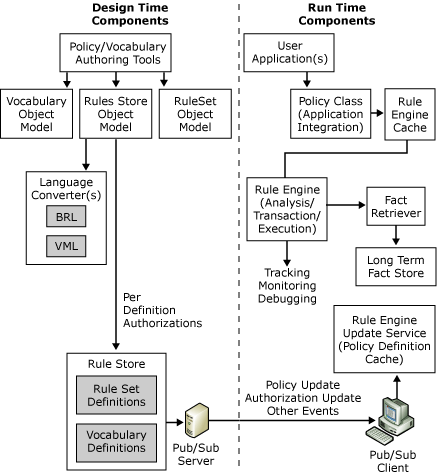Note
Access to this page requires authorization. You can try signing in or changing directories.
Access to this page requires authorization. You can try changing directories.
The following figure shows the component architecture of the Business Rules Framework.

Microsoft Business Rules Framework Architecture
Some of the components of the framework are described in the following paragraphs.
Policy Class
A Policy object is a single instance of a business policy, and provides the interface that is used by rule-based applications. It provides an abstraction that frees the application developer from concern about the location of the rule store, extracting rule sets from the rule store, instantiating instances of the underlying rule engine, and ensuring that long-term facts are asserted into the engine. In many scenarios, a rule-based application uses concurrent instances of the Policy object. These concurrent instances can represent the same policy, different versions of the same policy, or different versions of different policies.
RuleEngine Class
The RuleEngine object serves as the execution engine for business policies. It uses three plug-in components (translator, inference engine, and tracking interceptor) for implementation. A RuleEngine object takes a RuleSet object representing a business policy as input and uses the translator, inference engine, and tracking interceptor configured for the rule set to implement the business policy defined by the rule set.
Fact Retriever
A fact retriever is an optional, user-defined, plug-in component that is responsible for gathering long-term facts for use by business policies. For more information, see How to Create a Fact Retriever.
Before execution, a Policy object instance provides its RuleEngine instance to the fact retriever, giving it the opportunity to update the set of facts in the rule engine's working memory. For more information, see Short-Term Facts vs. Long-Term Facts.
Rule Engine Update Service
The Rule Engine Update service provides dynamic business policy updates in a distributed environment. An autostart Microsoft Windows NT service application is responsible for subscribing to policy deployment and undeployment events that occur when business policies are changed.
In a typical enterprise scenario, business policies are deployed after being updated, tested, and versioned. Deployment consists of adding the updated policy to a secure, persistent rule store and optionally executing logic on the store to publish information about the updated policy to all interested parties (note that information about the policy is published and not the policy itself).
The Rule Engine Update service, running on a server hosting rule-based applications, receives the policy update notification and caches the information for subsequent use. The use of a pub/sub model for policy updates enables you to change business policies in near real time without service downtime or interruption.
Policy/Vocabulary Authoring Tools
The Business Rule Composer in Microsoft BizTalk Server provides policy and vocabulary authoring capabilities to both end users and developers.
Rule Store
A rule store is a repository for business policies and vocabularies. The repository can be a simple file or a secure, scalable, persistent, and reliable database such as Microsoft SQL Server. (SQL Server is used as the default rule store for the framework).
Caching
The Business Rules Engine Framework provides a caching mechanism for RuleEngine instances. Each RuleEngine instance contains an in-memory representation of a specific policy version.
The following steps describe the process when a new Policy instance is instantiated (either with a call on the API or execution of the Call Rules shape):
The Policy object requests a RuleEngine instance from the rule engine cache.
If a RuleEngine instance for the policy version exists in the cache, the RuleEngine instance is returned to the Policy object. If a RuleEngine instance is not available, the cache creates a new instance. When a RuleEngine instance is instantiated, it does, in turn, create a new fact retriever instance if one is configured for the policy version.
When the Execute method is called on the Policy object, the following steps occur:
The Policy object calls the UpdateFactsmethod on the fact retriever instance if a fact retriever exists. The fact retriever's implementation of the method may assert long term facts into the working memory of the RuleEngine.
The Policy object asserts the short term facts contained in the Array that was passed in the Execute call.
The Policy object calls Execute on the RuleEngine.
The RuleEngine completes execution and returns control to the Policyobject.
ThePolicyobject retracts the short term facts from the RuleEngine. The long term facts asserted by the fact retriever will remain in the working memory of the rule engine.
After the Dispose method is called on the Policy object, the RuleEngine instance is released back to the rule engine cache.
The rule engine cache will have multiple rule engine instances for a given policy version if the load requires it, and each rule engine instance has its own fact retriever instance.